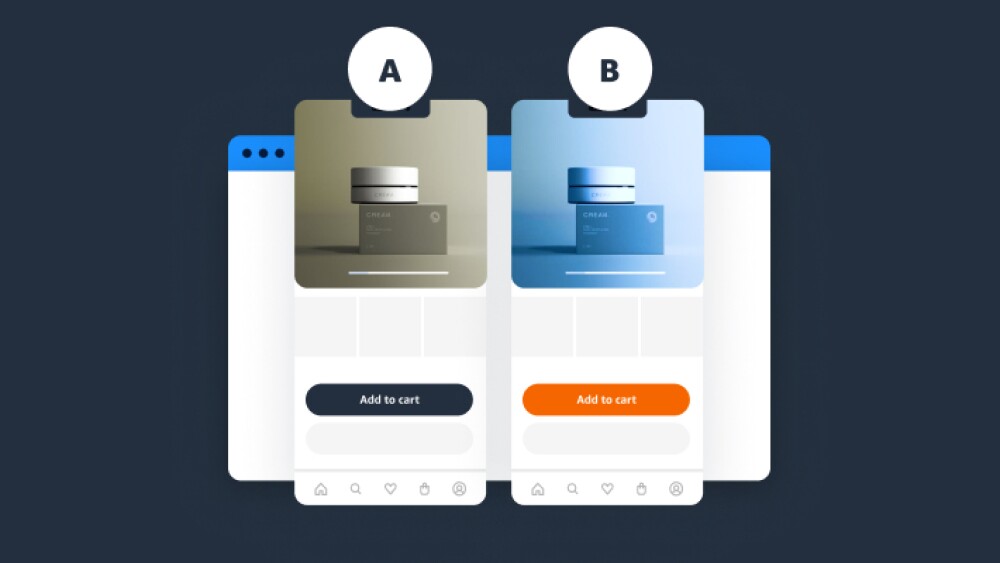The numbers are clear: adding Buy with Prime increases shopper conversions by 25% *, on average. More shoppers are likely to place an order when Buy with Prime is an available purchase option versus when it is not.
Merchants like Trophy Skin have reported an increase in shopper conversions by more than 30% since adding Buy with Prime to their online store. After Wyze saw a 25% spike in their conversion rate after adding Buy with Prime, they decided to add Buy with Prime to all of the eligible products in their catalog.
But how does Buy with Prime work for your site and your shoppers? What’s the ROI? And how can you optimize Buy with Prime to boost sales even further?
The best way to understand the business value Buy with Prime can bring to your site is through A/B testing . As a reminder, A/B testing is an experiment that tests two versions (a control group and a test group) of a user experience against each other to reveal which performs better based on your test goal.
Now, we’ve made it even easier to set up A/B experiments to inform your business decisions. Buy with Prime has partnered with an industry leading testing provider to offer a fully-funded solution for running tests on your site. Test results can include answers to questions about what copy, product images, colors, fonts, and layouts drive the most sales. By providing you with actionable data and insights in just a few weeks, controlled A/B testing can effectively mitigate the risk of adding Buy with Prime to your site.
With just a little additional work, you can maximize your conversions with key takeaways about the products that you choose to include. It’s important to keep in mind that the more you test—and the more products you activate—the greater your potential to reap the rewards of using Buy with Prime.
Here’s five helpful tips for using A/B testing to determine how Buy with Prime is performing on your site.
1. Establish your benchmarks for success
Before you start testing, establish a target baseline for the sales impact you’d like to see with Buy with Prime. We recommend defining an end goal for the sales growth you want.
After you’ve established your target, the next step is to define the acceptable growth percentage increments you want to see from each test. Those numbers will vary, depending on your business and product catalog.
While merchants using Buy with Prime see an average 25% increase in conversions, that is only an average. By establishing your initial baseline for success, you’ll be in a better position to establish realistic increments for growth, whether it’s 8%, 15%, or 25%. Then you can use iterative, ongoing A/B testing to achieve or even exceed your end goal.
2. Set up an account with the testing provider
Whether you use Shopify , BigCommerce , or another ecommerce provider, setting up A/B testing is easier than you think. You can get up and running in 15 to 30 minutes. There are two key actions you’ll need to take to set up testing on your site. First, you’ll need to set up an account with the testing vendor. After you’ve set up your account, you’ll need to add a code snippet from the testing vendor to your ecommerce provider site template. To get started, reach out to your sales representative.
3. Test your best performing products
For an A/B test to be truly valuable, your sample size needs to be large enough for the results to be statistically significant. Initially, we recommend testing at least 50% of your top selling items, but the more SKUs you make Buy with Prime-eligible, the more impactful the data. Tip: Testing your best performing SKUs by revenue and volume can give you meaningful results faster.
“Too often, we see merchants attempt to test the impact of Buy with Prime by making only a handful of SKUs eligible, and typically these are underperforming SKUs,” says Adrian Bell, Amazon’s principal product manager overseeing testing for Buy with Prime. “And, because the products are typically low volume to begin with, they just don’t see enough unit volume to get results that can help merchants see the ROI they’re seeking.”
4. Run multiple tests
After you’ve chosen a batch of high-performing products, your first basic test can show 50% of your shoppers those pages with Buy with Prime products (A or test group) versus 50% without (B or control group), over the same defined time period. A best practice to follow is running the test for four weeks, but as Bell points out, A/B testing isn’t a one-and-done proposition.
An initial test can give you a baseline for measuring the impact that Buy with Prime is having on your sales, but you can use the data from your initial test to inform future tests. That is, the winning first iteration can then become your new control group for your next test. You can then carry on testing and iterating incrementally—ideally, with each new control group outperforming the previous one.
5. Use data to get the most out of Buy with Prime
Through A/B testing, you can boost conversions by leveraging best practices to optimize your layout , messaging, product pages, collection pages , and marketing integrations to get the most out of Buy with Prime. With each change or design tweak you implement, you can set up a new A/B test to evaluate the impact in just a few clicks.
We’re constantly fine-tuning our A/B testing offering for merchants, so stay tuned for future updates about new ways we’re empowering merchants to get the most out of Buy with Prime.
Learn more about Buy with Prime .
* This data point measures the average increase in shoppers who placed an order when Buy with Prime was an available purchase option versus when it was not, during the same time period.

